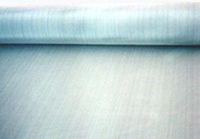
Stainless steel wire mesh and stainless steel wire cloth products are widely used in petroleum, chemical industry, environment protection, mine, airspace, paper-making,electronic, metallurgy etc. Special size and specification are available according to customers requirement.
Material for weaving stainless steel wire mesh ( wire cloth ) is divided into Type 304, Type 304 L, Type 316 and Type 316 L.
Type 304 is often referred to as "18-8" ( 18% chromium, 8% nickel ) with the basic stainless alloy mostly commonly, utilized for wire cloth weaving. It withstands outdoor exposure without rusting and resists oxidation at an elevated temperature up to 1400 Degrees Fahrenheit.
Type 304 L is very similar to T-304, the difference being the reduced carbon content for better weaving and secondary welding characteristics.
Type 316 Stabilized by the addition of 2% molydbenum, T-316 is an "18-8" alloy. It has better resistance to pitting corrosion than the other chromium-nickel stainless steels where brines, sulphur-bearing water or halogen salts, such as chlorides are present. A valuable property of T-316 is high creep strength at elevated temperatures. Other mechanical properties and fabricating characteristics are similar to T-304.
Type 316 L is very similar to T-316, the difference being the reduced carbon content for wire cloth weaving and secondary welding characteristics.
Material for weaving stainless steel wire mesh ( wire cloth ) is divided into Type 304, Type 304 L, Type 316 and Type 316 L.
Type 304 is often referred to as "18-8" ( 18% chromium, 8% nickel ) with the basic stainless alloy mostly commonly, utilized for wire cloth weaving. It withstands outdoor exposure without rusting and resists oxidation at an elevated temperature up to 1400 Degrees Fahrenheit.
Type 304 L is very similar to T-304, the difference being the reduced carbon content for better weaving and secondary welding characteristics.
Type 316 Stabilized by the addition of 2% molydbenum, T-316 is an "18-8" alloy. It has better resistance to pitting corrosion than the other chromium-nickel stainless steels where brines, sulphur-bearing water or halogen salts, such as chlorides are present. A valuable property of T-316 is high creep strength at elevated temperatures. Other mechanical properties and fabricating characteristics are similar to T-304.
Type 316 L is very similar to T-316, the difference being the reduced carbon content for wire cloth weaving and secondary welding characteristics.
Specifications
- divided
- into Type 304, Type 304 L, Type 316 and Type 316 L.
- Type 304
- Type 304 is often referred to as "18-8" ( 18% chromium, 8% nickel ) with the basic stainless alloy mostly commonly, utilized for wire cloth weaving. It withstands outdoor exposure without rusting and resists oxidation at an elevated temperature up to 1400 Degrees Fahrenheit
- Type 304 L
- Type 304 L is very similar to T-304, the difference being the reduced carbon content for better weaving and secondary welding characteristics.
- Type 316
- Type 316 Stabilized by the addition of 2% molydbenum, T-316 is an "18-8" alloy. It has better resistance to pitting corrosion than the other chromium-nickel stainless steels where brines, sulphur-bearing water or halogen salts, such as chlorides are present. A valuable property of T-316 is high creep strength at elevated temperatures. Other mechanical properties and fabricating characteristics are similar to T-304.
- Type 316 L
- Type 316 L is very similar to T-316, the difference being the reduced carbon content for wire cloth weaving and secondary welding characteristics.
Features
- divided
- into Type 304, Type 304 L, Type 316 and Type 316 L.
Main Products
metal wire and metal wire mesh
